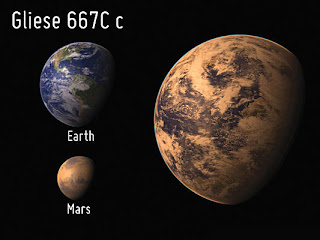Unofficial Names: Holy Grail of Exoplanets
Discovered: 21 November, 2011 (made public 2 February, 2012)
Discoverer: Steven S. Vogt et al
Mass: 4.1 - 4.9x that of Earth
Orbital Period: 28 days
Steven S. Vogt has done it again (or so my sources seem to imply, I can't find anything incontrovertible). And this time there's no denying him. Welcome to Gliese 667Cc, also coming to be known as the "Holy Grail of Exoplanets." Like Zarmina's World, Gl 667Cc rests squarely within the Goldilocks Zone. Unlike Zarmina's World, this one is 100% confirmed. It's nickname comes from the following statement made by Vogt, "It's the Holy Grail of exoplanet research to find a planet orbiting around a star at the right distance so it's not too close where it would lose all its water and not too far where it would freeze." Gl 667Cc makes the number two spot on the University of Puerto Rico's Habitable Planet List, with an astounding SE rating of 0.85 (Zarmina's World beats it out by 0.07 with an SE rating of 0.92). Although it is as perfectly "Goldilocks" as Zarmina's World, the factors that most likely reduce its SE rating are its greater mass (meaning higher gravity, roughly 2Gs) and even shorter orbital period. Like Zarmina's World, it is tidally locked, meaning that one side will always face the parent star while the other side always faces away. However, this doesn't mean the same thing for Gl 667Cc as it does for Zarmina's World.
You see, Zarmina's World orbits the red dwarf star Gliese 581, which like our sun is a single star. The Gliese 667 system, however, is not a single star. It isn't even a binary system. It is a trinary system. That means three stars orbiting each other. The smallest of these three is Gliese 667C, a red dwarf. It is unsurprising to find another Goldilocks planet orbiting a red dwarf. Red dwarfs are prime candidates for habitable worlds for a number of reasons which we shall not discuss here (perhaps in another, more star-related post). Since Gl 667C is the parent star, it will be giving constant day to the side of Gl 667Cc that faces it. However, the other side of the planet is not necessarily bathed in endless night. The other two stars would appear somewhat brighter than our moon. They would give enough light to provide a day/night cycle to the posterior half of the planet (though likely not as pronounced a cycle as we have on Earth). This would actually make the posterior half the more preferable side of the planet, unlike Zarmina's World where the anterior side is preferable. The fact that the Gl 667 system is trinary would also make the sky a marvelous sight to behold at any time of day.
Here is a picture comparing the approximate size of the planet (we can only guess at the size based on the known mass) with Earth and Mars, the habitable worlds of our own system. Scientists are confident that worlds such as Gl 667Cc or Zarmina's World will have some kind of life on them. Guillem Anglasa-Escude, one of the astronomers who supports Vogt's claims about Zarmina's World, had this to say about Gl 667Cc, Zarmina's World, and other habitable worlds around red dwarf stars, "With the advent of a new generation of instruments, researchers will be able to survey many dwarf stars for similar planets and eventually look for spectroscopic signatures of life in one of these worlds." While I highly doubt that we will ever encounter life on a scale comparable to humanity (the Bible does say we are the Crown of Creation, after all), I would not be surprised if we found plant life, fungi, and maybe even insects, birds, or primitive mammals on these worlds. It is fascinating to speculate whether these creatures will look anything like Earth's, or if they will be completely alien to us. Personally, I wouldn't put either option past our Creator. As more and more of these worlds are discovered, the exciting prospect of learning more about the universe our God has created grows beyond our wildest dreams. Who knows? Perhaps within our lifetimes the technology will exist to enable us to either visit these worlds, or at the very least see more accurate pictures of them. Gl 667 is only 22 lightyears away, after all (roughly the same distance as Gl 581). That's about 6 parsecs, and therefore right in our stellar neighbourhood. As Kingdom Come's song, "Stargazer" would put it, "Who knows what will come in time?"
Sources:



No comments:
Post a Comment